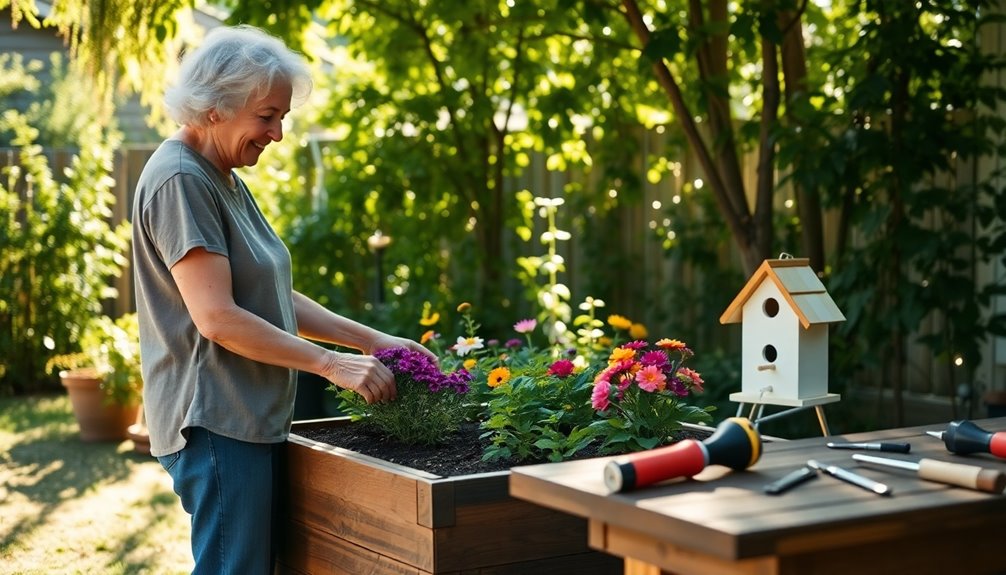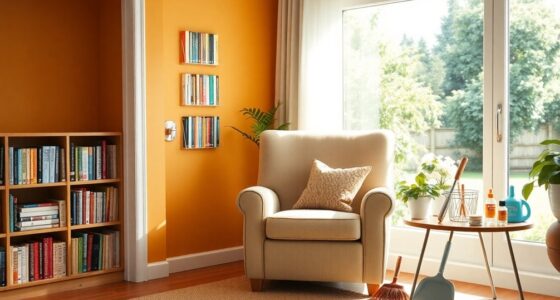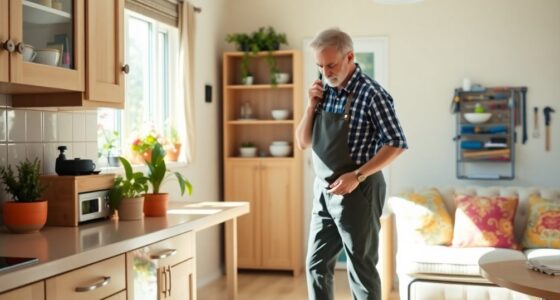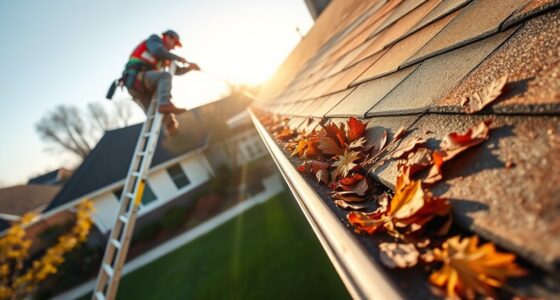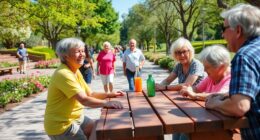If you’re looking to improve safety and accessibility for elderly homeowners, there are several DIY projects you can tackle! Start by widening doorways for easier mobility and installing lever-style doorknobs for simple access. Adding grab bars in bathrooms and creating walk-in showers can enhance safety. Don’t forget to replace flooring with slip-resistant materials and adjust kitchen countertops for comfort. You can even install motion sensor lighting and consider adding a stair lift or elevator. Discover more ideas that can make a difference! Additionally, incorporating brighter, more accessible lighting throughout the home can prevent accidents and make navigation easier. When planning these upgrades, it’s important to prioritize home improvement essentials for seniors, ensuring that every change not only enhances safety but also promotes independence. Consider involving elderly family members in the decision-making process to tailor the modifications to their specific needs and preferences.
Key Takeaways
- Install Motion Sensor Lighting to enhance safety in dark areas, reducing fall risks, and improving accessibility without professional help.
- Add Grab Bars in Bathrooms to prevent falls; these affordable installations promote independence during bathing and other daily activities.
- Replace Doorknobs with Lever-Style Options for easier access, reducing strain and improving safety for those with limited hand strength.
- Use Slip-Resistant Flooring in moisture-prone areas like kitchens and bathrooms to minimize slip and fall risks, ensuring a safer environment.
- Create a Maintenance Log to manage home care effectively, preventing minor issues from escalating into costly repairs and ensuring safety.
Widening Doorways for Improved Mobility

When you're considering modifications to make your home more accessible, widening doorways is an essential step. By increasing door widths to at least 32 inches, you facilitate wheelchair access and improve overall mobility.
This modification not only enhances accessibility but also creates a safer environment, reducing the risk of falls in tight spaces. The process typically involves replacing existing frames, adding insulation, and possibly relocating light switches.
Costs for widening doorways can range from $700 to $2,500 per doorway. It's wise to seek professional help for this project. Platforms like Angi and HomeAdvisor can connect you with contractors for estimates.
Ultimately, ensuring your doorways are adequately widened greatly contributes to an effective aging-in-place strategy.
Installing Lever-Style Doorknobs for Easier Access

Switching to lever-style doorknobs can make a big difference in your home's accessibility. These knobs are easier to grip and operate, especially if you have limited hand strength. Additionally, ensuring senior safety in your home can further enhance the overall living experience for elderly homeowners. Let's look at the benefits, tools you'll need, and a simple step-by-step guide for installation.
Benefits of Lever-Style Doorknobs
Lever-style doorknobs offer a simple yet effective solution for enhancing accessibility in your home, especially if you or a loved one struggles with hand strength or arthritis.
These doorknobs make it easier to grip and operate, eliminating the need for a twisting motion that can cause strain.
Here are some benefits of lever-style doorknobs:
- Ease of Use: Perfect for those with limited hand strength.
- Reduced Strain: No twisting required, minimizing wrist discomfort.
- Aesthetic Variety: Available in various designs and finishes to match your decor.
- Improved Safety: Enhances overall home safety and accessibility.
Switching to lever-style doorknobs can greatly contribute to a more comfortable living environment for seniors. Additionally, many advanced technology offerings improve the functionality of home accessories, making everyday tasks easier.
Tools Required for Installation
To successfully install lever-style doorknobs, you'll need a few essential tools to guarantee the process goes smoothly.
Start with a screwdriver and a measuring tape to ascertain the new knob fits your existing door. A chisel might be necessary for any adjustments that need to be made.
Check the backset measurement, which usually ranges from 2-3/8 inches to 2-3/4 inches, to confirm compatibility. Having a level on hand will help you mount the knob straight.
If you're replacing round doorknobs or working on new doors, a drill may be required to create new holes. For those with limited hand strength, using an electric screwdriver makes the installation process easier and minimizes physical strain in your home repairs.
Step-by-Step Installation Guide
Installing a lever-style doorknob can enhance accessibility and ease of use, especially for elderly homeowners. Here's a quick step-by-step guide for your DIY home project:
- Remove the existing round doorknob with a screwdriver, keeping any mounting plates intact.
- Measure the hole; verify it's a standard 2 1/8-inch bore for proper fit.
- Follow the manufacturer's instructions to attach the lever, aligning it with the latch mechanism.
- Test the lever by opening and closing the door to check functionality.
Finally, confirm the lever is secure. Make adjustments if necessary, especially to accommodate limited hand strength. Additionally, consider regular cleaning of air purifiers to ensure optimal performance and maintain a healthy living environment.
With these steps, you'll have a user-friendly doorknob that enhances your home's accessibility!
Adding Grab Bars in Bathrooms for Safety
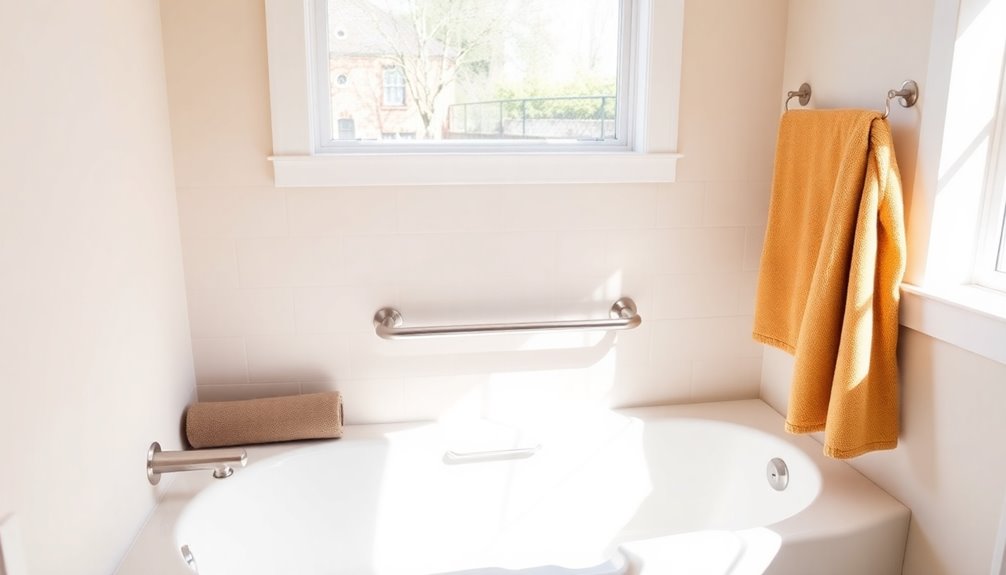
Since bathrooms can be particularly hazardous for elderly homeowners, adding grab bars is a smart way to enhance safety.
These essential features help prevent falls in slippery areas like tubs, shower stalls, and near toilets. You can find grab bars at home improvement stores for $20 to $50 each, making them an affordable modification.
For more complex installations, professional help might cost between $100 and $500. Installing grab bars not only boosts safety but also promotes your independence by providing support during daily activities like bathing. Additionally, proper post-operative care is essential when making modifications to ensure your safety and well-being.
Be sure to place them at appropriate heights and locations to guarantee maximum effectiveness and accessibility, allowing you to move confidently in your bathroom.
Creating Walk-In Showers for Safer Bathing
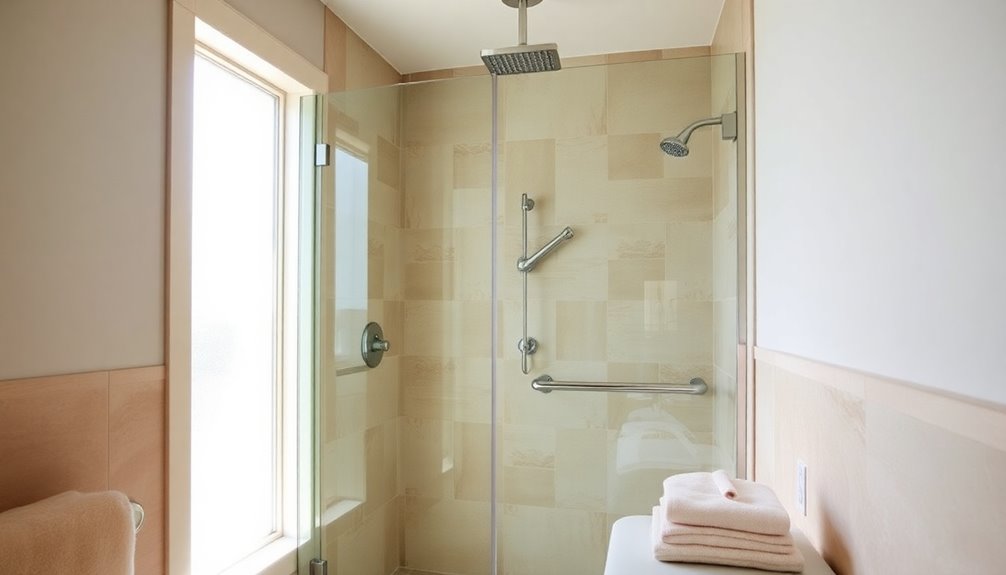
Creating a walk-in shower can dramatically improve safety for elderly homeowners, as it eliminates the need to step over high tub walls. This simple change can greatly reduce the risk of slips and falls.
While the average installation cost ranges from $6,000 to $12,000, investing in walk-in showers enhances both safety and accessibility.
Here are some essential features to take into account:
- Non-slip flooring options for better grip
- Grab bars for added support while bathing
- Barrier-free design for easy access
- Professional installation from experienced contractors
Consulting platforms like Angi can help you find reliable contractors to guarantee a seamless installation.
Replacing Flooring With Slip-Resistant Materials

Replacing your flooring with slip-resistant materials can greatly enhance safety in your home, especially in areas prone to moisture.
You'll find that easy installation techniques make it manageable, whether you're a DIY enthusiast or prefer to hire a professional.
Safety Benefits of Slip-Resistant Flooring
When it comes to ensuring a safe living environment for elderly homeowners, choosing slip-resistant flooring can make a significant difference.
By selecting the right materials, you can greatly reduce the risk of slips and falls, which are common hazards for seniors. Here are some important benefits to evaluate:
- Non-slip tiles are ideal for wet areas like bathrooms.
- Vinyl flooring offers durability and slip resistance for high-traffic areas.
- Slip-resistant flooring works well with mobility aids like walkers and wheelchairs.
- Repairing damaged flooring prevents trip hazards and enhances safety.
Investing in slip-resistant flooring not only provides peace of mind but also enhances the overall safety and comfort of your home.
Easy Installation Techniques
If you're looking to enhance safety in your home, installing slip-resistant flooring is a smart move. This DIY project can greatly reduce the risk of falls, especially in areas like bathrooms and kitchens.
Start by choosing materials like non-slip tile for wet areas or durable vinyl flooring, which accommodates mobility aids. Before installation, verify any existing flooring is repaired to eliminate trip hazards.
If you're unsure about the process, consult professionals or use platforms like Angi to find qualified contractors. With costs ranging from $3 to $14 per square foot, this project not only improves safety but also adds value to your home. Additionally, maintaining a clean living space is crucial for promoting overall health and wellness.
Creating a secure walking surface is essential for maintaining independence and peace of mind.
Installing a Wheelchair Ramp for Accessibility

Installing a wheelchair ramp can greatly enhance accessibility for elderly homeowners, ensuring they can move freely and safely around their property. This home improvement project not only improves mobility but also adds value to your home.
Here are some key points to take into account:
- Aim for a slope ratio of 1:12 for safety.
- Expect costs between $1,000 and $2,500, with wooden ramps being more affordable.
- Check local building codes for width and handrail requirements.
- Use a non-slip surface to prevent falls, especially during wet conditions.
Regular inspections and maintenance are essential to keep the ramp functional and safe.
Adjusting Kitchen Countertops for Comfort
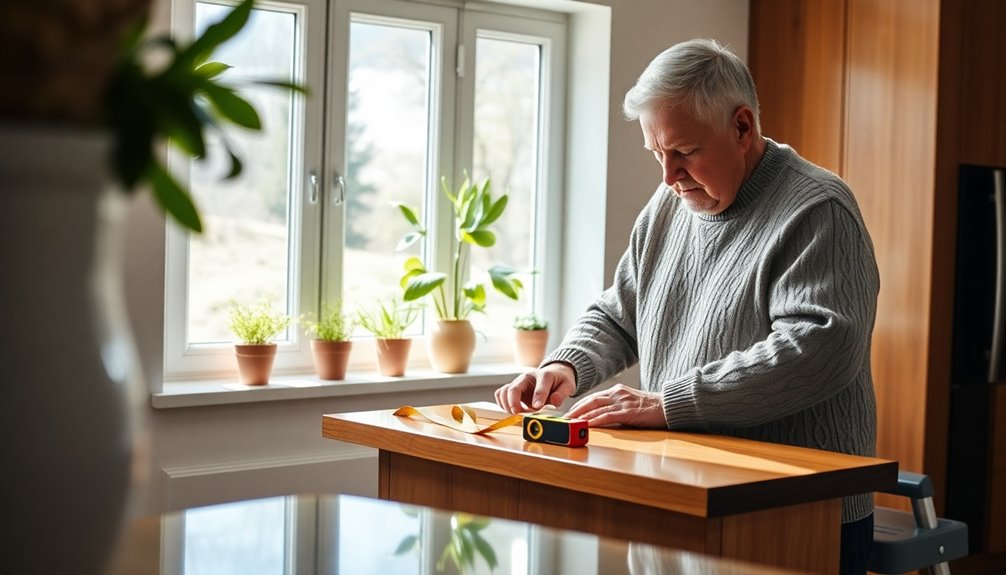
When adjusting kitchen countertops for comfort, you'll want to find the ideal height between 30 to 34 inches to make cooking easier.
Simple solutions like pull-out shelves can cut down on bending and reaching, making your kitchen more accessible.
Don't forget safety; rounded edges and contrasting colors can help prevent accidents while you work. Additionally, incorporating natural materials can enhance the overall aesthetic and provide a calming environment in your kitchen.
Optimal Height Adjustment
Adjusting kitchen countertops to the perfect height can greatly enhance your cooking experience, especially as you age. For ideal height adjustment, consider these key aspects:
- Aim for a height of 30 to 34 inches for general use.
- Adjust countertops to 34 to 36 inches for wheelchair accessibility.
- Use countertop extenders or pull-out shelves for added flexibility.
- Explore adjustable height countertops for various tasks and users.
These modifications can greatly improve comfort, reducing the need to bend or stretch while preparing meals. Additionally, ensure you understand the types of custody arrangements if children are involved, as this can influence family dynamics during kitchen use.
Don't forget to verify that all fixtures and appliances remain accessible, creating a functional kitchen layout tailored to your needs.
Embracing these changes can transform your kitchen into a more comfortable and enjoyable space!
Easy-to-Install Solutions
To create a more accessible kitchen, consider easy-to-install solutions that enhance comfort and usability for elderly homeowners.
Adjusting your kitchen countertops to a height of 34-36 inches can greatly reduce strain on your back and joints. You can DIY this by removing the current countertop and cutting down the cabinets to the desired height.
Additionally, installing pull-out shelves or drawer systems within your cabinets makes it easier to retrieve items without bending or reaching excessively.
If you prefer flexibility, look into countertop extensions or adjustable height solutions.
For personalized recommendations tailored to your mobility needs, consulting an occupational therapist can be invaluable. Incorporating pet therapy into your living space can also provide emotional comfort and companionship as you age in place.
These DIY maintenance projects can truly support your aging in place journey.
Safety Considerations for Seniors
Creating a safe kitchen environment for seniors goes beyond just comfort; it involves making practical adjustments that enhance usability.
When you modify your kitchen, consider these safety considerations for seniors:
- Adjust countertops to a height between 28 and 34 inches for easy access.
- Install pull-out shelves and drawers to minimize bending and reaching.
- Use rounded countertop edges to prevent injuries from bumps or falls.
- Add under-cabinet lighting to improve visibility while cooking.
Installing a Stair Lift or Elevator for Enhanced Mobility

When you consider how essential mobility is for maintaining independence at home, installing a stair lift or elevator can be a game-changer for elderly homeowners.
A stair lift is often a more affordable option, costing between $2,000 and $5,000, depending on the model and number of stairs. Most stair lifts can comfortably support up to 350 pounds, ensuring safety for most users.
On the other hand, if you're looking for a more permanent solution, residential elevators range from $15,000 to $50,000. Both options come equipped with safety features like seat belts and obstruction sensors, enhancing user security.
Plus, adding a stair lift or elevator can increase your home's value, making it more appealing for future buyers seeking aging-in-place solutions. Additionally, ensuring that spaces in the home are designed for accessibility can further enhance comfort and safety for elderly residents.
Improving Lighting With Motion Sensor Fixtures
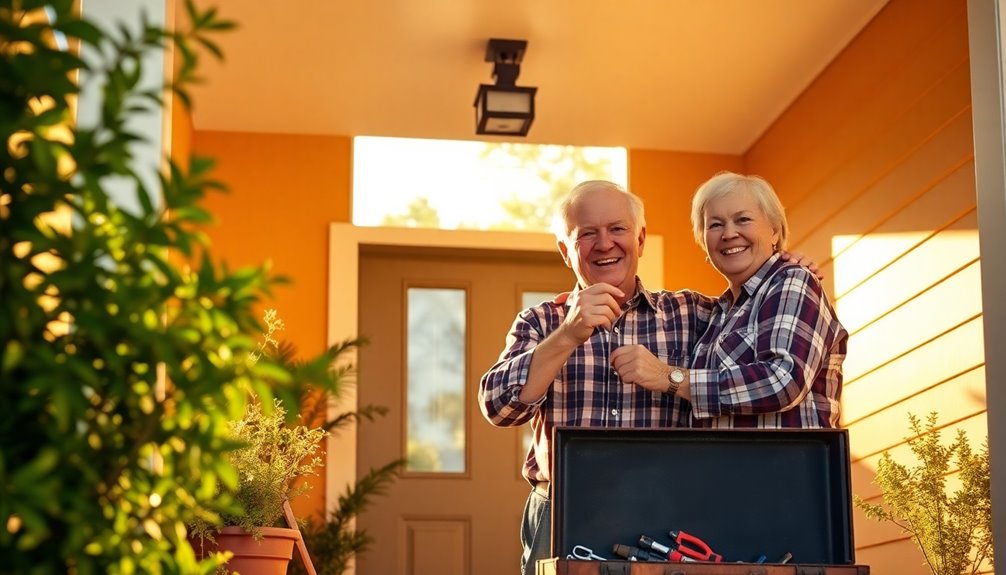
After enhancing mobility with a stair lift or elevator, improving lighting in your home can further boost safety and comfort. Motion sensor fixtures are a fantastic way to achieve this. They automatically turn on when they detect movement, providing immediate light in areas where visibility is essential, especially at night.
Consider these benefits of installing motion sensor lights around the home:
- Enhances safety by reducing fall risks in dark areas.
- Improves accessibility in key spots like entryways and bathrooms.
- Saves on energy costs with efficient LED options.
- Easy DIY installation—no professional help required!
Additionally, incorporating motion sensor lighting is an effective strategy to deter potential burglars, as it increases visibility and awareness around your property.
Creating a Maintenance Log for Ongoing Home Care

A well-organized maintenance log can be a game changer for elderly homeowners looking to manage their home care effectively. By tracking repairs and upkeep, you can prevent minor issues from escalating into costly problems, potentially saving up to 600% in repair costs. Your log should include dates, descriptions of repairs, and their completion status, helping you stay organized.
Here's a simple template to get you started:
| Date | Task Description |
|---|---|
| 01/15/2023 | Change HVAC filter |
| 02/20/2023 | Clean gutters |
| 03/10/2023 | Check smoke detectors |
| 04/05/2023 | Inspect plumbing fixtures |
| 05/12/2023 | Review electrical systems |
Using this maintenance log will help you prioritize tasks and guarantee your home remains safe and functional.
Frequently Asked Questions
What Is the 1% Rule for Home Maintenance?
The 1% Rule for home maintenance suggests you should budget about 1% of your home's value each year for upkeep and repairs.
If your home's worth $300,000, set aside roughly $3,000 annually.
This approach helps you avoid deferred maintenance, which can drastically increase repair costs.
What Is a Maintenance Plan for a House?
Did you know that deferred maintenance can hike repair costs by up to 600%? A maintenance plan for your house is essential.
It involves scheduling regular inspections and upkeep tasks to prevent minor issues from turning into major headaches. You should document and prioritize your maintenance needs, checking plumbing, HVAC systems, and safety devices seasonally.
Creating a checklist can help you stay organized and proactive, ultimately preserving your home's value and safety.
How to Learn Basic Home Maintenance?
To learn basic home maintenance, start by exploring online resources like video tutorials and DIY blogs. They offer step-by-step instructions that make it easy to grasp new tasks.
Consider joining local workshops where you can practice hands-on skills and meet others. Begin with simple projects, such as changing air filters or light bulbs, to boost your confidence.
Keeping a maintenance log will help you track tasks and develop a routine for home upkeep.
How to Properly Maintain a Home?
To maintain your home, think of it as a living entity that thrives on care.
Start with regular inspections—check for leaks, clean gutters, and change air filters.
Don't forget to inspect smoke detectors; they're your safety net.
Keep a maintenance log to track tasks and expenses, preventing minor issues from snowballing into costly repairs.
Engage community resources for bigger projects, ensuring your home remains a safe, comfortable haven for years to come.
Conclusion
By embracing these DIY projects, you're not just enhancing your home; you're crafting a sanctuary that dances with safety and comfort. Each tweak and turn transforms your space into a haven where mobility flows like a gentle stream. So, roll up your sleeves and let your creativity shine—these upgrades will not only brighten your days but also guarantee peace of mind. After all, a home that supports you is a home that truly thrives.
